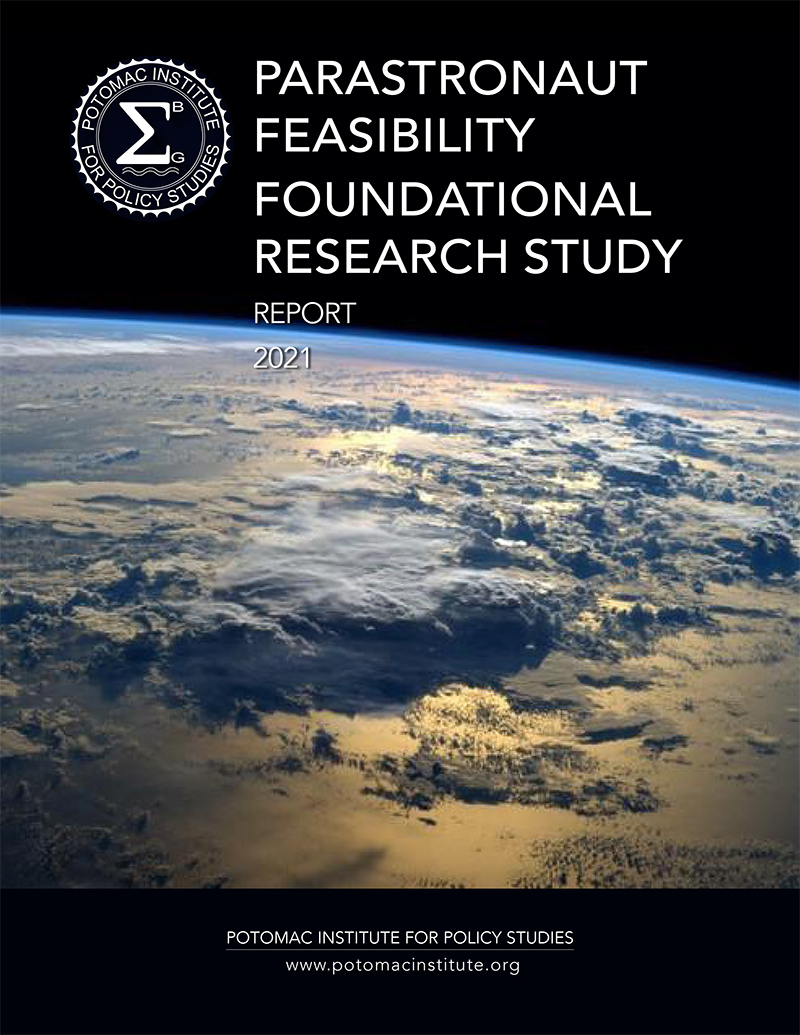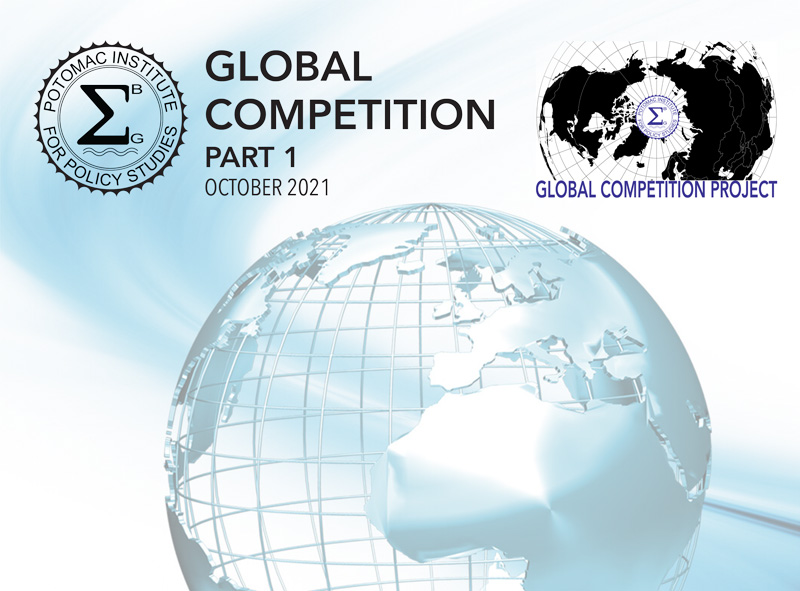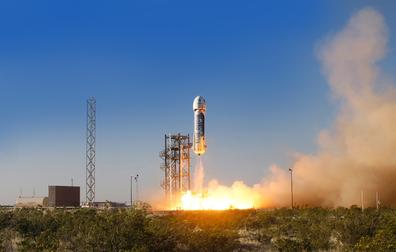Featured

 The Potomac Institute for Policy Studies is releasing the findings of a months-long study for the National Aeronautics and Space Administration’s (NASA) Office of the Chief Health Medical Officer entitled: “Parastronaut Feasibility Foundational Research Study”. NASA engaged the Institute to identify what it would take to fly astronauts with disabilities safely into space and back to Earth.
The Potomac Institute for Policy Studies is releasing the findings of a months-long study for the National Aeronautics and Space Administration’s (NASA) Office of the Chief Health Medical Officer entitled: “Parastronaut Feasibility Foundational Research Study”. NASA engaged the Institute to identify what it would take to fly astronauts with disabilities safely into space and back to Earth.
For years, NASA has selected astronauts based on certain physical parameters including having full, unobstructed use of limbs with little, if any, consideration to candidates who may not meet these criteria. This study looks specifically at astronauts with certain physical disabilities including individuals with lower leg deficiency, short stature, and/or leg length differences, among others. The Institute consulted with medical experts, military leaders, industry leaders, other organizations and stakeholders, and subject matter experts including former astronauts Former NASA Administrator Major General Charles Bolden and Former NOAA Administrator Dr. Kathy Sullivan. With their guidance, this report outlines policy recommendations, technical, medical, and operational hurdles, and considerations to make sure potential parastronauts can safely fly and contribute to space missions.
CEO of Potomac Institute Dr. Jennifer Buss stated, “There are ways to safely send parastronauts into space. It is vital NASA and space agencies around the world look to include a wider range of space flight candidates, and not exclude any potential exemplar astronaut candidates based on physical limitations that do not align with current technological and medical advances. Our findings and recommendations stem from months of data collected from interviews, research, and other methodologies.”
The Institute has two versions of the report to release. You can read an abbreviated version of the report here and the full version of the report is available here which will link to the Institute’s website. For interview requests with Institute staff or our subject matter experts, please contact Communications Director John Mecham at This email address is being protected from spambots. You need JavaScript enabled to view it..

 Global Competition Part I, October 2021
Global Competition Part I, October 2021
The inaugural event of the Potomac Institute’s Global Competition Project introduced several serious questions about the role and posture of the United States, inviting an animated discussion on a variety of topics important to the Institute’s work. These discussions focused on exploring what the United States should do in the future to lead and compete effectively on the world stage, especially given the dynamics of a tightly interwoven global economy and the technology-driven, wide proliferation of information.
The event allotted an opportunity for distin- guished members from across the Potomac Institute community to contribute expert insight on a range of topics that challenge the nation’s competitive stance. Topics ranged from contem- plating the implications of an exploding U.S. national debt to how COVID-19 related supply chain disruptions highlighted the United States’
reliance on foreign powers, to elevating how crucial STEM education is to ensuring U.S. leadership and prosperity in the future.
Speakers and participants also touched on the importance of honing the true nature of competition between the United States and China, and in what areas – economic, or from a military viewpoint, for example. While concluding the Chinese government is truly at odds with American values and our conception of free enterprise, not to mention other aspects of our culture and society, it was recognized that we must strive to understand each other better so we can all thrive, moving forward.
This GCP inaugural event was just the beginning, the foundation for a series of papers and events in months ahead that elevate and explore these challenging issues deeper in the context of the Institute’s overall mission.
Click here for more Information about the Global Competition Project

Big Things Come in Small Packages
The Fight for Semiconductor Manufacturing Supremacy
By: Theodore Bennett, Communications Department Intern
 Look around yourself, take in your surroundings. What do you see? Your computer obviously, maybe a phone. Oh, you’re feeling hungry? Grab something out of the fridge! Leftovers huh? Reheat those in the microwave, you have yourself a delicious meal. The Nationals are on later, grab a beer and watch the game. Your entire day, from the moment you wake up to when you drift off to sleep, is governed by little pieces of silicon.
Look around yourself, take in your surroundings. What do you see? Your computer obviously, maybe a phone. Oh, you’re feeling hungry? Grab something out of the fridge! Leftovers huh? Reheat those in the microwave, you have yourself a delicious meal. The Nationals are on later, grab a beer and watch the game. Your entire day, from the moment you wake up to when you drift off to sleep, is governed by little pieces of silicon.
Semiconductors, more commonly known as microchips, are the brains behind thousands of appliances that are part of the daily life of billions of people. They are the reason you are reading this article; they allow you to watch that show you love. Heck, they even keep your beer cold. Their uses are not restricted to such inconsequential activities though. International banking relies on semiconductors to initiate transfers of wealth. Governing countries would be impossible without these chips enabling faster communication and cooperation. In short, the world as we know would be impossible without semiconductors.
With the importance of semiconductors in our world, the significance of a continued supply of such chips is obvious. During Covid-19 that crucial supply chain was threatened. In March, Samsung’s co-chief executive and mobile chief, Koh Dong-Jin, acknowledged the challenge of the chip shortage at a shareholders meeting “There’s a serious imbalance in supply and demand of chips in the IT sector globally”. With the move home from work and school, people found themselves needing to upgrade their electronic equipment in order to support their new home-based lifestyle. This boost in demand for semiconductors coincided with a shock to the supply of microchips. Around the world, staff at semiconductor manufacturing factories, also known as “fabs”, were prevented from going to work by the pandemic. Taiwan, who provides around 63% of the world’s foundry semiconductors, was also affected by the worst drought it had faced in 50 years. Factories rely on ultra-pure water to produce semiconductors to avoid the contamination of electronic devices. This drought further exacerbated the semiconductor supply shortage. A key contributing factor was the “just in time” supply chain practices many suppliers had been using. These poor supply chain practices combined with the sudden increase in demand created huge shortages. This shortage is still affecting numerous companies and industries. According to analysis by Goldman Sachs, the shortage has already affected 169 industries. The shortage is unlikely to stop soon either. According to a report by Acer, the crisis is unlikely to be resolved until at least 2022.
In response to the crisis, US President Joe Biden signed an executive order addressing the chip shortage through a review of the semiconductor supply chain. The New Frontier Act, or USICA, is related to that executive order. USICA includes a 50-billion-dollar allocation to the Department of Commerce in order to fund domestic semiconductor manufacturing and research. At an event outside a Micron Technology Inc. chip factory, US Commerce Secretary Gina Raimondo said to reporters that the allocation could lead to an increase in domestic fabs, “Could be seven, could be eight, could be nine, could by ten new factories in America by the time we’re done”. Dr. Mike Fritze, a Vice President at the Potomac Institute and an expert in the field of Microelectronics, notes that this figure is, “practically too large given the available funding”. It still demonstrates though, USICA’s strong commitment to domestic semiconductor production.
The Department of Commerce will use the money to incentivize semiconductor manufacturing companies into establishing more US based fabs. According to Dr. Fritze, the Department of Commerce is likely to try enticing Semiconductor Manufacturing Companies to the US using financial encouragement, “The main lever…is likely to be tax incentives”. The act also included a 10.5 billion dollar allocation to the National Semiconductor Technology Center, National Advanced Packaging Manufacturing Program, as well as other research and development programs. While traditionally research towards the semiconductor industry has been focused on “smaller, cheaper, and faster”, Dr. Fritze notes that such a Center likely to use this money to focus on new innovative uses of semiconductors. He explains this change “The smallest features are now down to a few nanometers which is a countable number of atoms…you can’t have a half atom transistor…We can’t scale further so instead people are customizing their solutions to applications”. This new semiconductor research may include a focus on Artificial Intelligence, Quantum Computing, and even 5G. It should be noted that USICA has only passed in the Senate and not in the House of Representatives yet. This issue though, receives bipartisan support, so an agreement is likely eventually.
While there are semiconductors all around us, not every chip is made the same. Some semiconductors are more advanced than others. One Dutch company, ASML Holdings, provide the means for producing the most advanced chips in the world. Dr. Fritze explains, “ASML Holdings is widely regarded as the only company capable of making the lithography machines necessary for creating the most advanced chips”. ASML Holdings produces a machine that has the necessary lithography imaging system to create the most complicated chips in the world. Lithography is essentially, a light projection system which is used to create microchips. This machine, which has been called the “Tech Cold War’s Most Complicated Machine”, costs a cool 150 million dollars, is the only one of its kind on the market.
In 2019, the Trump administration was able to use its influence to convince the Dutch government to block the selling of these machines to China. This was a “defensive” act by the Trump administration. Dr. Fritze noted that this “Prevents China from being privy to the most advanced chips in the world”. This act gives the US and its allies an advantage in producing advanced semiconductors. While on the surface this is advantageous to American interests, it could have unintended consequences. China, faced with the prospect of falling behind the rest of the world in its ability to produce advanced chips, could look more towards Taiwan. China has already shown to be aggressive towards Taiwan, and according to Dr. Fritze, Taiwan has, “Some of the most advanced semiconductors factories in the world”. If China is unable to produce advanced semiconductors domestically, they may look to Taiwan and their factories. A worst case scenario of a Chinese invasion of Taiwan would be disastrous for the semiconductor industry. Dr. Fritze explains, “Such an invasion of Taiwan would have a calamitous effect on the American semiconductor supply chain”. Chinese control of Taiwan would mean Chinese dominance over the world’s foundry semiconductor supply. The purpose of the New Frontier Act may be partly to combat that worst case scenario. Promoting additional domestic semiconductor fabrication plants will help secure America’s semiconductor supply chain. Dr. Fritze notes how USICA adds to the previous work done to secure American semiconductor interests, “In many ways the New Frontier act plays offense to the Trump administrations defense”. USICA decreases America’s reliance on foreign made chips and adds funding towards research and development in the semiconductor industry.
While a Chinese invasion is the worst case scenario in terms of supply chain risk, the heavy concentration of fabs in Asia is in itself a threat. Over 86% of the world’s chips are manufactured in Asia, with Taiwan alone manufacturing 63% of the world’s foundry chips. This heavy concentration of fabs thousands of miles away from the U.S. represents an overall geopolitical risk for semiconductor access.
Semiconductors are vital components of our everyday life. Despite their importance, America has relied heavily on foreign chip manufacturers. During Covid-19, due to a global shortage, America’s supply of semiconductors was threatened. In order to protect against potential future supply chain weaknesses, the Senate passed the New Frontier Act. While it has yet to pass in the House of Representatives, USICA is likely to address American reliance on foreign chip manufacturers by incentivizing the building of domestic semiconductor factories. The passing of USICA should help defend the US semiconductor supply chain from many future risks.

 The Potomac Institute is proud to welcome Dr. Robie Samanta Roy to our Board of Regents. Dr. Samanta Roy is the Chief Operating Officer of Electra.aero, a next-gen aerospace company devoted to sustainable advanced air mobility, headquartered in Northern Virginia.
The Potomac Institute is proud to welcome Dr. Robie Samanta Roy to our Board of Regents. Dr. Samanta Roy is the Chief Operating Officer of Electra.aero, a next-gen aerospace company devoted to sustainable advanced air mobility, headquartered in Northern Virginia.
He most recently was the Vice President of Technology – Government Affairs at Lockheed Martin where he was responsible for supporting corporate engagements with the US Government science and technology community across the United States. Dr. Samanta Roy also served as Lockheed Martin’s first Corporate Vice President for Technology Strategy and Innovation under the Chief Technology Officer where he developed and provided technical intelligence and strategy for the corporation, engaged the global S&T ecosystem outside the corporation, and fostered cross-enterprise innovation.
“I am truly honored to join the ranks of the Potomac Institute’s Board of Regents and contribute to the Institute’s mission of ensuring that the nation’s decision makers are provided with the very best in science and technology policy analysis, insights and advice,” said Dr. Samanta Roy.
Prior to joining Lockheed Martin, Dr. Samanta Roy was a professional staff member with the Senate Armed Services Committee with the portfolio of the Department of Defense’s wide spectrum of science and technology-related activities including test and evaluation. He came to that position from the White House Office of Science and Technology Policy where he was the Assistant Director for Space and Aeronautics and was responsible for space and aeronautics activities ranging from human space flight to the Next Generation Air Transportation System. He also served as a Strategic Analyst at the Congressional Budget Office and as a Research Staff Member in the Systems Evaluation Division of the Institute for Defense Analyses.
“We are honored and excited to welcome Dr. Samanta Roy to our Board of Regents,” said General Al Gray, Chairman of the Board of Regents and Board of Directors at Potomac Institute. “Dr. Samanta Roy brings years of expertise in industry and government to our organization. He joins an exceptional group of Regents who we rely on to help our team serve our country for the public good. We look forward to his expertise and insight on the work we will be doing.”
Dr. Samanta Roy earned his Bachelor of Science, Master of Science and Ph.D. degrees in aeronautics and astronautics from MIT. He earned a master’s degree in space policy from George Washington University and diplomas from the International Space University and Institut d’Etudes Politiques de Paris.
He is a Fellow and a recent member of the Board of Trustees of the American Institute of Aeronautics and Astronautics and a member of the National Research Council’s Aeronautics and Space Engineering Board. He is on the FAA’s Drone Advisory Committee and from 2015-2019 chaired the Industry Relations Committee of the International Astronautical Federation. He is a Reservist in the U.S. Space Force.

The Race to Space Today: Billionaires and Collaboration
By: Vanessa Guigon, Communications Department Intern
 The race to space is drastically different today than it was during the Cold War. The space race during the Cold War consisted of the U.S. and the Soviet Union (now the Russian Federation) competing to be world leaders and dominate space. Now, the space race consists of the U.S. delegating some authority in space development and commercial space tourism to private companies, with some billionaires taking advantage of the opportunity to go to space. On July 20, 2021, Reuters reported that billionaire Jeff Bezos flew on his spacecraft, New Shepard, with his crewmates for a successful 10 minute trip. His success comes only nine days after British billionaire Sir Richard Branson completed his first fully crewed space flight on July 11, 2021. The U.S. government is looking to work with billionaires and other private companies, given how on July 12, 2021 NASA announced the launch of its 2021 Entrepreneurs Challenge, which calls for participants to develop new technologies that advance NASA’s goals. The race to space is now expanding to include billionaires and private companies, with collaboration still being a crucial element.
The race to space is drastically different today than it was during the Cold War. The space race during the Cold War consisted of the U.S. and the Soviet Union (now the Russian Federation) competing to be world leaders and dominate space. Now, the space race consists of the U.S. delegating some authority in space development and commercial space tourism to private companies, with some billionaires taking advantage of the opportunity to go to space. On July 20, 2021, Reuters reported that billionaire Jeff Bezos flew on his spacecraft, New Shepard, with his crewmates for a successful 10 minute trip. His success comes only nine days after British billionaire Sir Richard Branson completed his first fully crewed space flight on July 11, 2021. The U.S. government is looking to work with billionaires and other private companies, given how on July 12, 2021 NASA announced the launch of its 2021 Entrepreneurs Challenge, which calls for participants to develop new technologies that advance NASA’s goals. The race to space is now expanding to include billionaires and private companies, with collaboration still being a crucial element.
Billionaires are achieving their goals in the quest to reach space. The world’s richest man, Jeff Bezos, founded the company Blue Origin about 20 years ago. His company’s spacecraft, New Shepard, is named after Alan Shephard, who was the first American in space in 1961. The July 20 flight occurred on the anniversary of Neil Armstrong and Edwin “Buzz” Aldrin being the first humans to walk on the moon, which was on July 20, 1969. According to Reuters, the New Shepard flight was also historic because Wally Funk, 82, and Oliver Daeman, 18, both aboard the spacecraft, became the oldest and youngest people to reach space. The other billionaires involved in space industry pioneers include British billionaire Sir Richard Branson and Tesla’s founder, Elon Musk. Sir Richard Branson began planning for his space flight 17 years ago when he founded his company, Virgin Galactic Holding Inc, in 2004. His dream became reality on July 11, 2021 when he boarded his Virgin Galactic rocket plane, SpaceShipTwo VSS Unity, and flew at least 50 miles over the New Mexico desert, with the trip lasting approximately an hour. In addition, Elon Musk’s company, SpaceX, is planning on sending its first all-civilian crew into space in September 2021. With billionaires incorporating themselves and their companies in the space race, NASA is looking for opportunities to collaborate with the public.
The entrance of billionaires in the development of the space industry signals the presence of private companies in the race to space, especially with the announcement of NASA’s 2021 Entrepreneurs Challenge. On July 12, 2021, NASA announced the 2021 challenge to “invite fresh ideas and new participants” in the creation of new technologies that can advance NASA’s mission at lower costs, with a special emphasis on “reaching out to underserved communities.” As an incentive for entrepreneurs to participate, NASA’s Science Mission Directorate will award finalists as much as $90,000 through the completion of both stages of the competition. Round One of the competition will involve participants submitting a five-page white paper describing their idea, and those chosen for Round Two will be tasked with submitting a longer and more in-depth white paper and pitching their idea in a live Virtual Pitch Event. While NASA has relinquished some control over their space dominance, such as by ending the Space Shuttle Program in 2011, the 2021 Entrepreneurs Challenge showcases NASA’s intent to collaborate with private companies to help further space exploration.
While space exploration now includes private companies and billionaires, there is another important aspect to consider regarding the space race- international relationships. Potomac Institute Senior Fellow and Board of Regents member Major General Charles Frank Bolden Jr. (USMC-Ret.), a former NASA astronaut and the former NASA Administrator, believes that “the key to success for any of our deep exploration of space going forward is [...] our international relationships” because without those relationships the U.S. could fall behind other nations in the race to human spaceflight. Major General Bolden claims “the more the merrier,” in regards to who the U.S. should work with in the pursuit of space exploration. Looking to the future, Major General Bolden believes that “the 2030s will be focused on sending humans to Mars.” The work done by the Potomac Institute is seeking to contribute to the achievement of those goals.
Collaboration between NASA and the Potomac Institute is furthering the advancement of space exploration. The Potomac Institute is in the midst of working with NASA on a variety of projects aiming to improve the technological developments for space exploration. These projects include working with the Human Research Program within NASA to improve strategic planning for human space exploration, along with modernizing their data management system. The Potomac Institute is also working with the Office of Chief Health Medical Officer, which oversees health and medical policy at NASA, providing strategic analysis and policy recommendations related to astronaut medical standards and requirements. While the actors involved in the race to space today have expanded, collaboration is crucial for the success of human spaceflight.
